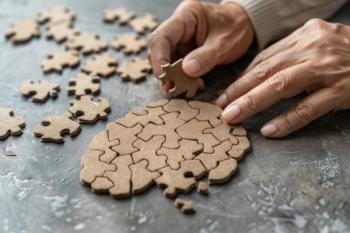
- Vol 37, Issue 11
- Volume 37
- Issue 11
Treating Dementia Patients in the Time of COVID
Telehealth poses challenges for patients, clinicians, families, and caregivers.
COMMENTARY
I am looking forward to seeing “Mr Walker,” a gregarious man with an engaging smile, whose cognitive functioning has gradually declined over the past 4 years. I click his name in our telehealth waiting room. The screen lights up and through a fuzzy computer connection I see him.
He looks around, bewildered. He hears my voice but cannot determine from where it is coming. He cannot focus on the computer screen in front of him and does not know what is required of him. A voice from the side says, “Dad there’s the doctor. Didn’t you want to ask him something?” The patient stares blankly and asks, “Where? I don't see him.” To that, I say cheerfully, “Hello Mr Walker,” and I get a glimpse of his familiar smile before he falls back into the chair in silence.
Early claims that telehealth is “virtually perfect”1 do not fit well with our experience with dementia patients. It has been more than 5 months since our team saw our dementia patients in-person. Some we will never see again, as they have succumbed to the coronavirus. Others survived the battle with the virus, but their brains were injured on the battlefield, and their dementia progressed to a more severe stage of deterioration. We have muddled through using telehealth—usually with video but sometimes by phone—but it is not the same as pre-COVID-19 care.
Our patients and their caregivers (mostly indigent, minorities, and immigrants) often do not have the bandwidth connections to achieve optimal video images. This is not an ideal situation for patients with disorders that impair their intellectual and social functioning. They cannot see or hear us very well, and they may become more confused by the video interface or retreat into the background. We cannot be sure if they are getting clinically worse or whether the technology is creating surplus deficits.
We have adjusted how we treat patients, and the jury is still out as to the impact of these changes. For example, during the peak of the pandemic, we weighed the infection risks of obtaining blood work or neuroimaging in labs or radiology centers. These risks seemed to outweigh the benefits. On the other hand, because COVID-19 can present atypically in dementia patients,2 we were more vigilant concerning changes in their behavior, function, or cognitive status, and encouraged patients to obtain in-person medical evaluations, perhaps sooner than under normal circumstances. Sometimes with telehealth we must forgo smaller things, even if they are important for good geriatric care. Thus, checking blood pressure sitting and standing, checking pulse rate and rhythm, measuring weight—none of it is done if family members do not have the equipment.
The COVID-19 pandemic eviscerated the patients’ community support programs. Keeping people active in the day translates to calmer and more restful nights, and research suggests that
What does this mean clinically? Early in the crises, close-knit family structures unwittingly spread the contagion. To protect their loved ones, caregivers faced the challenge of limiting personal contacts with children, grandchildren, friends, or other relatives. Outdoor activities had to be restricted as well. Thus, they do not go to parks, houses of worship, supermarkets, or restaurants. Commonly, patients complain of
Increased reliance on medications, however, even when used judiciously, generates concerns in caregivers and physicians.
The good news is that we have been sending fewer condolence cards. We hope that a second wave will not arise, and we await the reemergence of the support network so vital for our patients and caregivers. Before the pandemic, such networks were underappreciated and underfunded by legislators; now, we fear curtailment from prior levels of services as states and cities struggle to balance their budgets. Taking care of persons with dementia and their caregivers is 1 of the most socially interactive specialties in medicine, and we are eager to see them in-person again. But because our patients are high-risk, they are first out and last in for office visits.
So we plod on, honing our telehealth skills and maximizing its benefits. For instance, we have found that telehealth can unobtrusively bring together clinicians and students from various disciplines into the patient’s room, as well as provide “home visits” for trainees who rarely see where patients live.
For now, I turn my swivel chair toward the luminous high-pixilated LED screen, put on my wireless, noise-canceling headphones, and like an internet-age version of the bemused Dr Bernard Rieux in
Dr Cohen is State University of New York Distinguished Service Professor & Director of the Division of Geriatric Psychiatry at SUNY Downstate Medical Center. He is also the founding director of the Center of Excellence for Alzheimer’s Disease at SUNY Downstate Medical Center and the Geriatric Psychiatry Fellowship Program. The author receives support from the Health Services Research Administration Geriatrics Workforce Enhancement Program-COVID; Grant no. T1MHP39042.
This article was originally posted on September 18, 2020, and has since been updated. Scroll down for the
References
1. George, J. Telehealth boom misses older adults. MedPage Today. August 4, 2020. Accessed 9/15/2020.
2. Naarding P, Oude Vashar RC, Marijnissen RM. COVID-19: Clinical challenges in Dutch geriatric psychiatry. Am J Geriatr Psychiatry. 2020; 28(8):839-843.
3. Mather M, Scommegna P. The Demography of Dementia and Dementia Caregiving. Program and Policy Implications. Population Reference Bureau working paper 40. May 2020.
4. Jia RX, Liang JH, Xu Y, Wang YQ. Effects of physical activity and exercise on the cognitive function of patients with Alzheimer disease: a meta-analysis. BMC Geriatr. 2019;19(1):181. Published 2019 Jul 2.
5. Azarpazhooh MR, Amiri A, Morovatdar N, et al. Correlations between COVID-19 and burden of dementia: An ecological study and review of literature. J Neurol Sci.2020;416: 117013.
6. Camus A. The Plague. Vintage Books; 1991.
Articles in this issue
about 5 years ago
Discharge Planningabout 5 years ago
Patients Like Telehealth, But Barriers Still Persistabout 5 years ago
Nitrous Oxide and Alexander Hamilton’s Grandsonabout 5 years ago
Psychiatry’s Role in the Management of Chronic Painabout 5 years ago
Sleep Disturbances as a Sequalae of Chronic Painabout 5 years ago
What’s in a Name: The Problem with Zero Suicideabout 5 years ago
Can Exercise Decrease Mortality Risk in Patients With Depression?about 5 years ago
Combination Therapy for Treatment-Resistant Schizophrenia?Newsletter
Receive trusted psychiatric news, expert analysis, and clinical insights — subscribe today to support your practice and your patients.




